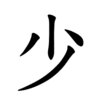少
| ||||||||
Translingual
| Stroke order | |||
|---|---|---|---|
| Stroke order | |||
|---|---|---|---|
 | |||
Alternative forms
Han character
少 (radical 42, 小+1, 4 strokes, cangjie input 火竹 (FH), four-corner 90200, composition ⿱⿻丨八丿(GT) or ⿱小丿(HJKV))
Derived characters
References
- KangXi: page 296, character 20
- Dai Kanwa Jiten: character 7475
- Dae Jaweon: page 590, character 2
- Hanyu Da Zidian: volume 1, page 561, character 2
- Unihan data for U+5C11
Chinese
| simp. and trad. |
少 | |
|---|---|---|
Glyph origin
| Historical forms of the character 少 |
|---|
| Shang |
| Oracle bone script |
 |
| Characters in the same phonetic series (小) (Zhengzhang, 2003) | |
|---|---|
| Old Chinese | |
| 觘 | *sm̥ʰreːw, *sm̥ʰreːws |
| 抄 | *sm̥ʰreːw, *sm̥ʰreːws |
| 鈔 | *sm̥ʰreːw, *sm̥ʰreːws |
| 訬 | *sm̥ʰreːw, *mewʔ |
| 炒 | *sʰroːʔ |
| 吵 | *sm̥ʰreːwʔ, *mewʔ |
| 耖 | *sm̥ʰreːws |
| 仯 | *sm̥ʰreːws |
| 眇 | *mewʔ |
| 渺 | *mewʔ |
| 杪 | *mewʔ |
| 秒 | *mewʔ |
| 篎 | *mewʔ, *mews |
| 妙 | *mews |
| 玅 | *mews |
| 釥 | *sm̥ʰewʔ |
| 小 | *smewʔ |
| 少 | *hmjewʔ, *hmjews |
| 麨 | *m̥ʰjewʔ |
| 尠 | *senʔ, *smos |
Pictogram (象形) – four dots; few; little. Compare 小 (OC *smewʔ, “small”), which is depicted by three dots.
Pronunciation 1
Definitions
少
- few; little in number; less; not many
- weak; inadequate; insufficient
- † Alternative form of 小 (xiǎo, “small; tiny”).
- to lack; to be short of; to be deficient
- to reduce (the amount or extent); to weaken; to lose; to stop; to cease
- † to despise; to look down; to belittle
- slightly; moderately; a little; a bit
- seldom; rarely; infrequently
- in a little while; in a moment
- 5th tetragram of the Taixuanjing (𝌊)
Antonyms
- (few): 多 (duō)
Compounds
Derived terms from 少
|
|
Pronunciation 2
Definitions
少
Compounds
Derived terms from 少
|
|
Japanese
Readings
Korean
This article is issued from
Wiktionary.
The text is licensed under Creative
Commons - Attribution - Sharealike.
Additional terms may apply for the media files.